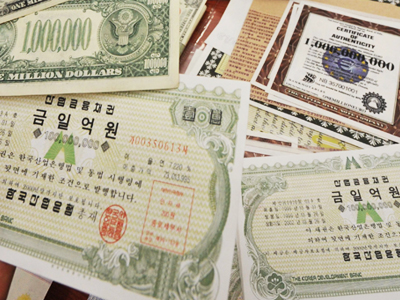채권은 앞에서 언급한데로 기업이나 국가에서 자금을 조달하기 위해서 발행합니다. 채권을 발행할 때 미리 정해진 채권가격(face value)이 있습니다. 이러한 채권을 구입하면 만기가 되는 날(maturity date)에 미리 정해진 이자(coupon)와 함께 돌려받는 것입니다. 그러나 주식(stocks)은 이익배당금(dividend)과 수익률(return)을 보장하지 않습니다.
예를 들어 봅니다.
You buy a bond with a $1,000 face value, a 5% coupon and a 10-year maturity. You would collect interest payments totaling $50 in each of those 10 years. When the decade was up, you'd get back your $1,000 and walk away.
5% 이자율과 10년 후 만기가 되는 1,000달러 채권을 구입하면 매년 50달러의 이자를 10년 동안 받습니다. 그리고 10년 후에는 원금 1,000달러를 돌려받는 것입니다.
Price In The Market
So far we've discussed the factors of face value, coupon, maturity, issuers and yield. All of these characteristics of a bond play a role in its price. However, the factor that influences a bond more than any other is the level of prevailing interest rates in the economy. When interest rates rise, the prices of bonds in the market fall, thereby raising the yield of the older bonds and bringing them into line with newer bonds being issued with higher coupons. When interest rates fall, the prices of bonds in the market rise, thereby lowering the yield of the older bonds and bringing them into line with newer bonds being issued with lower coupons.
지금까지 채권의 가격, 이자, 만기일 등에 대해서 알아보았습니다. 이 모든 것이 채권가격과 상관관계과 있습니다. 그러나 채권가격과 가장 밀접한 관계를 가지고 있는것은 이자율(interest rate)입니다. 앞에서 언급한대로 이자율이 올라가면 채권가격이 떨어진다고 했습니다.
그렇다면 왜 이자율이 오르면 채권가격이 떨어질까요?
이유는 간단합니다. 보유하고 있는 채권에서 4% 이자를 받는다고 가정합시다. 이자율이 올라감에 따라서 은행에 저금한 돈, CD(Certificate Deposit), Money Market, 등에서 5%의 이자를 준다면 당연히 많은 사람들이 은행으로 투자를 합니다.
이러한 시점에서 새롭게 발행되는 채권의 이자 역시 올라갑니다. 이러한 이유로 현재 보유하고 있는 채권가격이 떨어질 수 밖에 없는 것이고, 이러한 이유로 채권가격은 이자율과 매우 밀접한 관계가 있는 것입니다.
Copyrighted, 영민엄마와 함께하는 재정계획All rights reserved.
'영민 엄마의 재정계획' 카테고리의 다른 글
| 2010년의 재정계획 결심(Resolution) (0) | 2010.01.08 |
|---|---|
| 새해인사 - 건강하십시요 (0) | 2010.01.03 |
| 조심해야 할 2010년의 채권(Bond) 투자 (0) | 2009.12.25 |
| 기술적 분석 소개 하편 (0) | 2009.12.11 |
| 기술적 분석 소개 상편 (0) | 2009.12.08 |




